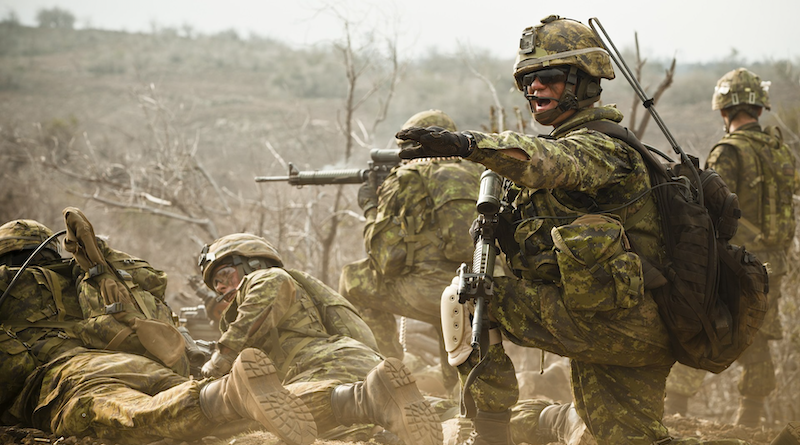Canadian Armed Forces Are In Crisis – OpEd
By Tim Dunne
“We need to rebuild the Armed Forces, we need to get the numbers back up,” Chief of the Defence Staff Gen. Wayne Eyre told the Canadian Press.
“And we’ve got to do it with a sense of urgency and priority because it is affecting our ability to respond around the world.”
It sounds dire, and it is.
Many of our older retired members would point an accusing finger at Paul Hellyer’s unification of the Canadian military in 1968 as the start of the problems, and they would be right. Unification is cursed for separating the service member from her and his service. It was the absurd and reckless act of a politician whose ambitions exceeded his capabilities.
Unification removed the service identifications from the navy, army and air force. All were given a common shiny green polyester uniform that couldn’t hold a crease, had a magnetic attraction for lint and through which you could blow cigarette smoke.
Morale was difficult wearing a uniform that did nothing to shield a service member from freezing winter temperatures.
It left many of our sailors, soldiers and aviators rudderless as the Armed Forces entered a period of profound change in our social society, law and growing expectations of our public institutions.
But unification was only the beginning of a long litany of problems.
Sexual abuse, misconduct and harassment within the military is so widespread that one could be forgiven for believing it was a conscious policy to discourage women from military service.
There have been some disturbing events.
Women’s rights advocate, author and writer Julie Lalonde was heckled by the Royal Military College audience in 2015 as she lectured about the impact of sexual misconduct.
Former RMC director of cadets, Lt.-Col. Mark Popov, left the Forces in 2018 after being diagnosed with PTSD, which he said was linked to the toxic environment he had to deal with at the college.
In 2015, Popov confronted a group of RMC cadets who spoke about threatening to rape a group of women. The cadets complained to their fathers, senior officers at National Defence Headquarters. Popov was abruptly reassigned and ultimately left the military. The cadets are the future leaders of the Armed Forces.
Two high-profile studies were done by former justices of the Supreme Court of Canada ― Marie Deschampes and Louise Arbour — to identify and address the root causes.
The issue is well-studied. Perpetrators had better be careful or DND might do yet another study.
Then there is the military justice system.
A former girlfriend reported pilot instructor Maj. Cristian Hiestand to military police at CFB Moose Jaw for sexual assault after he ended their brief relationship. Hiestand’s family retained former military legal officer Lt. Col. (retired ) Rory Fowler, who said the military police declined to interview Hiestand before charging him. They “had all the evidence they needed to prosecute him,” he told the CBC.
Convinced he would never eliminate the stigma of being charged, he took his own life.
Speaking to the investigator wouldn’t have made any difference. In my experience, military police investigators disregard information and avoid evidence that doesn’t support their efforts to incriminate the suspect. In the minds of MPs and military prosecutors, once accused you are deemed guilty. If not charged or if the individual is acquitted, the attitude of the military prosecutor is that he/she “appears to have escaped formal disciplinary action.”
Former Toronto lawyer Edward Greenspan compared police to ducks: all enthusiasm at one end and irresponsibility at the other. The same could be said of military police and military lawyers.
The military police have changed their objectives. Where once they focused their efforts to prevent difficulties for service personnel, they appear to now take particular pride in charges and prosecution. The higher the rank the bigger their bragging rights.
Unification began the deterioration of the military ethos, exacerbated by the Canadian military justice system, but there were other factors that pushed the process along.
The military deployments to Oka, Que., (July to September 1990) and the Persian Gulf (August 1990 to June 1991) ushered in an era of an increased operational tempo: the deployment to the Balkans (1991-2010), Somalia (1992-93), Rwanda (1993-96), Afghanistan (2001-14) and multiple deployments to Haiti, to mention a few.
A result of these deployments was post-trauma stress disorder among our military and recent veterans becoming a major concern. Homelessness, depression, couch surfing, impoverishment and suicides became sources of discussion and concern.
These events happened against the backdrop of Jean Chretien’s decade of darkness (1993-2003), when military salaries and benefits were frozen, when our Somalia peacekeepers were denied their operation medals for years, when it took 20 years to replace the venerable Sea King maritime patrol helicopter, when the government treated our military as a piece of gum on the bottom of their collective shoe.
Eyre makes no secret that the Armed Forces are in an existential crisis. Ten per cent of military positions are unoccupied and recruiting programs can’t seem to resolve the problem. The general is trying to muster public support for the military leadership’s efforts to build up our defence forces.
Perhaps these circumstances discourage recruiting and encourage retirement, resignation and renouncement.
Tim Dunne is a retired Canadian military public affairs officer with 37 years’ service in Canada, the United States, Europe, the Middle East and Africa.
This article was first published at Saltwire


Excellent article